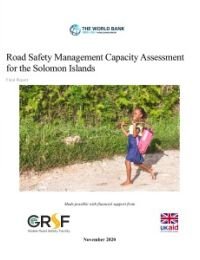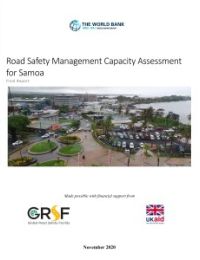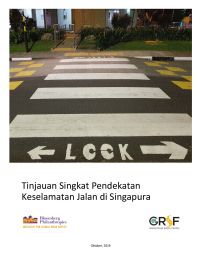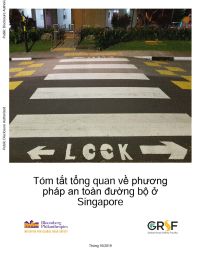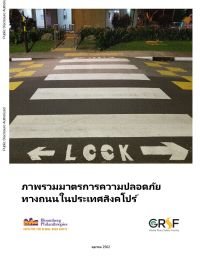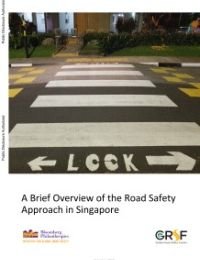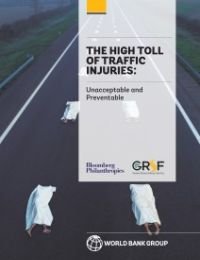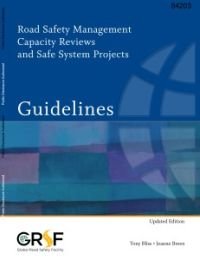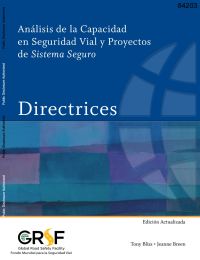Publications
51-60 of 62
-
-
Road Safety Management
Road Safety Management Capacity Assessment for the Solomon Islands
February 2021
-
-
Utilize GRSF recommended methodology to gain a thorough understanding of road safety management capacity;
-
Assess institutional management arrangements as an important focus of the analysis of the road safety system in Samoa;
-
Consider the existing national road safety strategy—Samoa National Action Plan (SNAP) for the Decade of Action for Road Safety 2011-2020—and propose updates for the next period;
-
Provide capacity building on crash investigation and evidence-based road safety measures to ensure success and sustainability, with a focus on vulnerable road users such as females, children, and persons with disabilities; and,
-
Focus on crash data management, including providing hands on capacity building and crash analysis.
-
Road Safety Management
Tinjauan Singkat Pendekatan Keselamatan Jalan di Singapura (Indonesian)
October 2019
-
Road Safety Management
Tóm tắt tổng quan về phương pháp an toàn đường bộ ở Singapore (Vietnamese)
October 2019
-
-
-
-
Cutting traffic deaths and injuries by half could add 7 to 22% to GDP per capita over 24 years in select countries
-
Welfare benefits equivalent to 6 to 32% of GDP per capita could be realized over the same period if traffic deaths and injuries were halved
-
Road traffic injuries are the single largest cause of mortality and long-term disability among people aged 15-29, prime working age
-
Reducing the number of RTIs leads to long-term national income growth. This correlation is easy to establish as RTIs are the single largest cause of mortality and long-term disability among young people aged 15-29 (prime working age).
-
Significant long-term income growth—7 to 22% increase in GDP per capita over 24 years—can be achieved by halving road traffic deaths and injuries, in line with the current UN targets.
-
The study goes beyond productivity or economic gains, and highlights the broader welfare benefits associated with reducing road traffic mortality and morbidity, adding years of life free of injuries and lasting disabilities. This recognizes that GDP is an imperfect measure of social welfare, as it does not factor health benefits. The study finds welfare benefits equivalent to 6 to 32% of the national GDP can be realized from reducing road deaths and injuries by 50% over 24 years.
-
By maximizing healthy years of life, free of injuries and disabilities, actions to reduce road traffic injuries can help countries increase productivity, enhance the well-being of their populations, and build human capital—a key developmental priority for the World Bank.
-
Road safety goes beyond the transport sector, with a direct impact on public health, societies, and economies. Likewise, because road safety is an inherently cross-sectoral issue, real progress can only happen if all relevant stakeholders unite their efforts.
-
Road Safety Management
Road Safety Management Capacity Reviews and Safe System Projects Guidelines
May 2013
-
Specify a management and investment framework to overcome institutional capacity barriers and support the successful implementation of road safety interventions;
-
Provide practical procedures designed for application at a country level to accelerate knowledge transfer and sustainably scale up investment to improve road safety results;
-
Ensure that institutional strengthening initiatives are properly sequenced and adjusted to the absorptive and learning capacity of the country concerned.
-
Road Safety Management
Análisis de la Capacidad en Seguridad Vial y Proyectos de Sistema Seguro (Spanish)
May 2013
- Especificar un marco de gestión e inversión para superar las barreras de capacidad institucional y apoyar la implementación exitosa de intervenciones de seguridad vial;
- Proporcionar procedimientos prácticos diseñados para su aplicación a nivel de país para acelerar la transferencia de conocimientos y aumentar de manera sostenible la inversión para mejorar los resultados de seguridad vial;
- Garantizar que las iniciativas de fortalecimiento institucional estén debidamente secuenciadas y ajustadas a la capacidad de absorción y aprendizaje del país en cuestión.
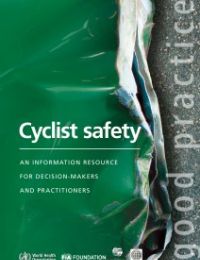
Cycling has many health and environmental benefits. Yet every year 41 000 cyclists die in road traffic-related crashes worldwide. Many leave their homes as they would on any normal day – for school, work, worship, or meeting friends – never to return. Millions more people are injured in road traffic-related crashes while cycling, some of whom become permanently disabled. These incidents cause much suffering and grief, as well as economic hardship for families and loved ones.
However, the growing focus on sustainable mobility – an increasing effort to shift more travel from motorized transport to the use of public transport, walking and cycling – makes cyclists’ safety an increasingly important component of road safety efforts. Cyclist collisions, like other road traffic crashes, are predictable and preventable and therefore should not be accepted as inevitable.
Cyclist safety: an information resource for decision-makers and practitioners describes the magnitude of cyclist death and injury, the key risk factors, and effective interventions. The document stresses the importance of a comprehensive, holistic approach that includes legislation, enforcement and behavioral measures specifically for cyclists; design of the built environment; as well as integrating cyclist safety into overall road safety and transport strategies. It also draws attention to the benefits of cycling, which should be promoted as an important mode of transport given its potential to improve health and preserve the environment.
We hope that this resource, which is designed for a multidisciplinary audience including engineers, planners, law enforcement officers, public health professionals and educators, will contribute towards strengthening national and local capacity to implement cyclist safety measures in various settings worldwide. We encourage all to bring this resource to the attention of those who will use it to save the lives of cyclists.
The World Health Organization (WHO) coordinated the production of this resource. Soames Job, Head GRSF and Global Lead Road Safety, World Bank was one of the principal writers of this document. GRSF contributions to this document were supported by UK Aid.
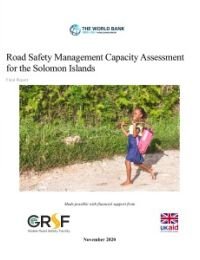
This Road Safety Management Capacity Assessment (RSMCA) seeks to gain a broad understanding of the Solomon Island Government road safety management capacity in order to support the country's development of a national strategy and plan of action to improve road safety outcomes, and subsequently implement those actions effectively.
The RSMCA follows the seven critical road safety institutional management functions (Bliss and Breen 2013) to identify key challenges and provide recommendations for improvement in road safety management, and similarly addresses the Safe System pillars for the interventions level. The seven institutional management functions include: results focus; coordination; legislation; finance and resource allocation; promotion and advocacy; monitoring and evaluation, and research and development of knowledge transfer.
The Safe System pillars include road safety management; safe roads and mobility; safe vehicles; safe road users, post-crash care; and safe speeds. As such, the RSMCA outlines key findings and recommendations relating to both the road safety institutional management functions within the Solomon Islands, and the Safe System Approach, whilst also identifying targeted priority next steps to address road crash death and serious injury in the country.
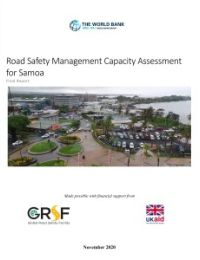
The Road Safety Management Capacity Assessment (RSMCA) is an activity within a broader Advisory Services and Analytics (ASA), which aims to gain a holistic and thorough understanding of the road safety management capacity of three selected Pacific Island Countries (PICs)—Samoa, the Solomon Islands and Vanuatu—in order to support their respective governments to develop national strategies and plans of action to improve road safety outcomes, with a focus on crash data management. The ASA will also support a pilot of the World Bank’s Data for Road Incident Visualization, Evaluation, and Reporting (DRIVER) road crash database in Samoa and provide hands on capacity building in crash analysis.
The ASA is being funded by a Global Road Safety Facility (GRSF) grant from the United Kingdom Agency for International Development (UK AID). The GRSF grant will help the Government of Samoa (GoS) to have a clear image of their road safety situation, risks and challenges, and further on to establish the basis for a national crash database. To ensure sustainability through capacity building and awareness-raising activities, knowledge will be shared with local stakeholders.
The key objectives of this ASA are as follows:
An auxiliary objective is to build capacity to use crash data to identify problems and implement road safety evidence-based measures in Samoa. Furthermore, given the negative impacts of severe weather events on road safety, which will be further exacerbated by climate change, the ASA will help to address the way that road safety is managed in the face of climate change, by training police officers to gain better skills in crash investigation.
The results from the DRIVER pilot in Samoa will be shared with counterparts in selected other PICs, with the aim of scaling up the system across the region. Only with accurate data can road safety be effectively managed and improved, and results measured. In support of this, as of October 2019, the World Bank’s Environmental and Social Framework (World Bank 2019) calls for road safety to be considered on all World Bank-funded projects.
The World Bank is also currently providing assistance to the road sector in Samoa through several projects, including the Samoa Climate Resilient Transport Project (SCRTP), which commenced in 2018. SCRTP will support the GoS to improve the climate resilience of the road network and provide key assistance required to contribute towards effectively managing climate resilient and safe road sector assets. One of the sub-components of SCRTP is dedicated to establishing and operationalizing a database for recording and analyzing road crash data.
The database will combine the existing siloed data, housed in different government agencies, into a single readily accessible platform under the Ministry of Work, Transport and Infrastructure (MWTI). The system will make use of DRIVER, to be piloted through this road safety ASA. SCRTP has other sub-components and activities focused on road safety, such as Road Safety Audits for project roads, a driver licensing training pilot focusing on women, and a road safety engineering technical assistance activity. This GRSF ASA will provide crucial data and insight for the successful delivery of the road safety program under SCRTP, plus other ongoing World Bank-financed projects.
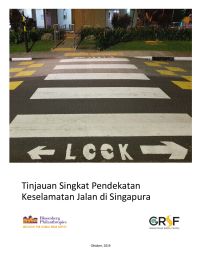
Laporan ini memperkenalkan cara kerja Pendekatan Sistem Aman, dengan fokus pada infrastruktur jalan dan praktik terbaik rekayasa keselamatan jalan dari salah satu negara dengan kinerja terbaik di Asia Tenggara dan Pasifik, Singapura.
Jalan-jalan di Singapura tidak hanya dianggap sebagai yang teraman di kawasan ini, tetapi juga termasuk yang teraman di dunia. Aturan dan regulasi manajemen keselamatan jalan yang diterapkan di negara ini telah menghasilkan langkah-langkah signifikan dalam mengelola dampak faktor tabrakan yang terkait dengan desain jalan raya, perilaku manusia, dan atribut kendaraan. Hasilnya, statistik keselamatan jalan menunjukkan bahwa jumlah kematian di jaringan jalan Singapura terus menurun selama dekade terakhir. Hal ini mendorong keinginan negara-negara tetangga untuk mengikuti contoh Singapura dan belajar dari pengalamannya.
Untuk mengurangi tabrakan yang disebabkan oleh kekurangan atau kerusakan kendaraan, salah satu langkah yang diambil di Singapura adalah memberlakukan kebijakan impor kendaraan yang ketat. Impor kendaraan diizinkan dari negara-negara yang telah mengadopsi dan mematuhi standar keselamatan kendaraan tinggi yang diakui. Kepatuhan terhadap keselamatan kendaraan secara khusus difokuskan pada 52 item yang ditetapkan oleh Otoritas Transportasi Darat (LTA). Selain standar impor kendaraan yang ketat, Singapura memberlakukan sistem kuota kendaraan yang ketat, yang mengatur jumlah kendaraan di jaringan jalan. Selain itu, kendaraan diharuskan menjalani inspeksi berkala. Mobil berusia antara 3 dan 10 tahun diharuskan menjalani inspeksi dua tahunan, dan mobil yang berusia lebih dari 10 tahun diharuskan menjalani inspeksi tahunan.
Selain itu, taksi diharuskan menjalani inspeksi setiap enam bulan. Pendidikan keselamatan jalan dan pendidikan pengemudi merupakan prinsip utama strategi keselamatan jalan Singapura. Pendidikan keselamatan jalan sebagian besar dilakukan oleh Polisi Lalu Lintas Singapura, tetapi organisasi nonpemerintah seperti Sekretariat Koordinasi Keamanan Nasional memberikan kontribusi yang signifikan terhadap pendidikan keselamatan jalan di Singapura.
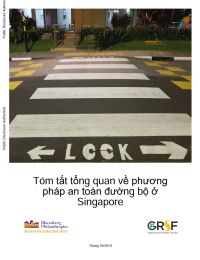
Báo cáo giới thiệu cách thức hoạt động của Phương pháp tiếp cận hệ thống an toàn, tập trung vào cơ sở hạ tầng đường bộ và các biện pháp thực hành tốt nhất về kỹ thuật an toàn đường bộ từ một trong những quốc gia có thành tích tốt nhất ở Đông Nam Á và Thái Bình Dương, Singapore.
Đường bộ Singapore không chỉ được coi là an toàn nhất trong khu vực mà còn được xếp hạng là một trong những quốc gia an toàn nhất trên toàn cầu. Các quy tắc và quy định về quản lý an toàn đường bộ được thực hiện tại quốc gia này đã mang lại những bước tiến đáng kể trong việc quản lý tác động của các yếu tố va chạm liên quan đến thiết kế đường bộ, hành vi của con người và các thuộc tính của phương tiện. Do đó, số liệu thống kê về an toàn đường bộ cho thấy số ca tử vong trên mạng lưới đường bộ Singapore đã giảm đều đặn trong thập kỷ qua. Điều này dẫn đến mong muốn của các quốc gia láng giềng là noi gương Singapore và học hỏi kinh nghiệm của nước này.
Để giảm thiểu các vụ va chạm do xe không đủ tiêu chuẩn hoặc lỗi, một trong những biện pháp được thực hiện tại Singapore là thực thi chính sách nhập khẩu xe nghiêm ngặt. Xe được phép nhập khẩu từ các quốc gia đã áp dụng và tuân thủ các tiêu chuẩn an toàn xe cao được công nhận. Việc tuân thủ an toàn xe đặc biệt tập trung vào 52 mục do Cơ quan Giao thông Đường bộ (LTA) chỉ định. Ngoài các tiêu chuẩn nhập khẩu xe nghiêm ngặt, Singapore còn thực thi hệ thống hạn ngạch xe nghiêm ngặt, quy định số lượng xe trên mạng lưới đường bộ. Ngoài ra, xe phải được kiểm tra thường xuyên. Xe từ 3 đến 10 năm tuổi phải được kiểm tra hai năm một lần, và xe trên 10 năm tuổi phải được kiểm tra hàng năm.
Ngoài ra, xe taxi phải được kiểm tra sáu tháng một lần. Giáo dục an toàn giao thông và giáo dục lái xe là những nội dung cốt lõi trong chiến lược an toàn giao thông của Singapore. Giáo dục an toàn giao thông chủ yếu do Cảnh sát giao thông Singapore thực hiện, nhưng các tổ chức phi chính phủ như Ban thư ký điều phối an ninh quốc gia cũng đóng góp đáng kể vào giáo dục an toàn giao thông tại Singapore.

รายงานนี้แนะนำวิธีการทำงานของแนวทางระบบที่ปลอดภัย โดยเน้นที่โครงสร้างพื้นฐานทางถนนและแนวทางปฏิบัติที่ดีที่สุดด้านวิศวกรรมความปลอดภัยทางถนนจากหนึ่งในประเทศที่มีประสิทธิภาพสูงสุดในเอเชียตะวันออกเฉียงใต้และแปซิฟิก ซึ่งก็คือสิงคโปร์
ถนนในสิงคโปร์ไม่เพียงแต่ถือว่าปลอดภัยที่สุดในภูมิภาคเท่านั้น แต่ยังติดอันดับถนนที่ปลอดภัยที่สุดในโลกอีกด้วย กฎและข้อบังคับด้านการจัดการความปลอดภัยทางถนนที่นำมาใช้ในประเทศได้ส่งผลให้มีความก้าวหน้าอย่างมากในการจัดการผลกระทบของปัจจัยการชนที่เกี่ยวข้องกับการออกแบบถนน พฤติกรรมของมนุษย์ และคุณลักษณะของยานพาหนะ ส่งผลให้สถิติความปลอดภัยทางถนนแสดงให้เห็นว่าจำนวนผู้เสียชีวิตบนเครือข่ายถนนของสิงคโปร์ลดลงอย่างต่อเนื่องในช่วงทศวรรษที่ผ่านมา ส่งผลให้ประเทศเพื่อนบ้านมีความปรารถนาที่จะทำตามตัวอย่างของสิงคโปร์และเรียนรู้จากประสบการณ์ของประเทศ
เพื่อบรรเทาการชนที่เกิดจากความไม่เพียงพอหรือข้อบกพร่องของยานพาหนะ มาตรการอย่างหนึ่งที่ใช้ในสิงคโปร์คือการบังคับใช้นโยบายนำเข้ายานพาหนะที่เข้มงวด การนำเข้ายานพาหนะได้รับอนุญาตจากประเทศที่ได้นำมาตรฐานความปลอดภัยของยานพาหนะระดับสูงที่เป็นที่ยอมรับมาใช้และปฏิบัติตาม การปฏิบัติตามข้อกำหนดด้านความปลอดภัยของยานพาหนะนั้นเน้นเป็นพิเศษที่รายการ 52 รายการที่กำหนดโดย Land Transport Authority (LTA) นอกเหนือจากมาตรฐานการนำเข้ายานพาหนะที่เข้มงวดแล้ว สิงคโปร์ยังบังคับใช้ระบบโควตายานพาหนะที่เข้มงวด ซึ่งควบคุมจำนวนยานพาหนะในเครือข่ายถนน นอกจากนี้ ยานพาหนะยังต้องผ่านการตรวจสภาพบ่อยครั้ง รถยนต์ที่มีอายุระหว่าง 3 ถึง 10 ปีต้องผ่านการตรวจสภาพทุก ๆ สองปี และรถยนต์ที่มีอายุมากกว่า 10 ปีต้องผ่านการตรวจสภาพทุกปี
นอกจากนี้ รถแท็กซี่ต้องผ่านการตรวจสภาพทุก ๆ หกเดือน การศึกษาความปลอดภัยบนท้องถนนและการศึกษาของผู้ขับขี่ถือเป็นหลักการสำคัญของกลยุทธ์ความปลอดภัยบนท้องถนนของสิงคโปร์ การศึกษาความปลอดภัยบนท้องถนนส่วนใหญ่ดำเนินการโดยตำรวจจราจรของสิงคโปร์ แต่หน่วยงานที่ไม่ใช่ของรัฐ เช่น สำนักงานเลขานุการประสานงานด้านความมั่นคงแห่งชาติ มีส่วนสนับสนุนอย่างมากในการให้ความรู้ด้านความปลอดภัยบนท้องถนนในสิงคโปร์
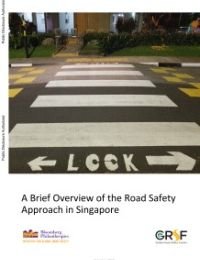
The report introduces how the Safe System Approach works, with a focus on road infrastructure and road safety engineering best practices from one of the best performing countries in Southeast Asia and the Pacific, Singapore.
Singapore roads are not only considered the safest in the region, they rank among the safest globally. Road safety management rules and regulations implemented in the country have resulted in significant strides in managing the effects of collision factors related to roadway design, human behavior, and vehicle attributes. As a result, road safety statistics have shown that fatalities on the Singapore road network have been steadily declining over the past decade. This is leading to a desire on the part of neighboring countries to follow Singapore's example and learn from its experience.
In order to mitigate collisions attributed to vehicle inadequacies or defects, one of the measures taken in Singapore was to enforce a strict vehicle import policy. Vehicle imports are permissible from countries that have adopted and comply with recognized high vehicle safety standards. Vehicle safety compliance is particularly focused on 52 items specified by the Land Transport Authority (LTA). In addition to strict vehicle import standards, Singapore enforces a strict vehicle quota system, which regulates the number of vehicles on the road network. Additionally, vehicles are required to undergo frequent inspections. Cars between 3 and 10 years old are required to have a biennial inspection, and cars older than 10 years are required to undergo annual inspections.
Furthermore, taxis are required to undergo inspections every six months. Road safety education and driver education are core tenants of Singapore's roads safety strategy. Road safety education is predominately undertaken by the Singapore Traffic Police, but nongovernmental organizations such as the National Security Coordination Secretariat contribute significantly to road safety education in Singapore.
Document also available in : Thai, Bahasa (Indonesian), Bahasa (Indonesian), Vietnamese
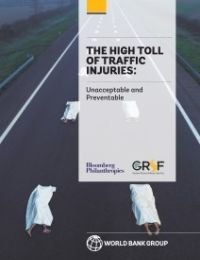
Key Findings ⌵︎
Each year, 1.25 million people lose their lives on the world’s roads and another 20 to 50 million are seriously injured. The tragic loss from a road traffic death or serious injury is compounded by the harm to households and social networks. A disproportionate 90% of road traffic injuries (RTIs) occur in low- and middle-income countries (LMICs), representing a major public health and economic burden. This is an eminently preventable problem that is critical to the development agenda. Unfortunately, due to lack of solid data, the impact of road injuries on economic growth and social welfare has been difficult to assess.
A new World Bank report funded by Bloomberg Philanthropies, The High Toll of Traffic Injuries: Unacceptable and Preventable, looks to fill the gap. It proposes a comprehensive methodology to quantify both the income growth and social welfare benefits that safer roads could bring to developing countries. The analysis is based on data collected from 135 countries over 24 years, and focuses on China, India, the Philippines, Tanzania, and Thailand—five geographically, demographically and economically diverse LMICs.
The study shows that reducing the number of RTIs in developing countries not only increases income growth, but also generates substantial welfare benefits to societies.
Key findings from the report include:
> Press Release: Road Deaths and Injuries Hold Back Economic Growth in Developing Countries

The Road Safety Management Capacity Reviews and Safe System Projects Guidelines have been designed to assist country road safety professionals, World Bank and regional development bank staff, international consultants, community groups, private sector organizations, and all other global, regional and country partners and stakeholders to conduct capacity reviews and prepare follow-up road safety projects in a variety of low and middle-income countries and investment settings.
The purpose of the Guidelines is to:
The Guidelines emphasize managing for results and the associated strengthening of country road safety management systems, with special attention being paid to the role of the lead road safety agency in ensuring institutional effectiveness and efficiency in program delivery. They highlight the importance of addressing all elements of the road safety management system, taking a staged approach to country road safety investment, and targeting the highest concentrations of deaths and injuries across the road network.
For more information visit this page.
This report is also available in:
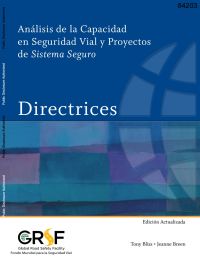
Las Directrices para los proyectos de sistemas seguros y las revisiones de la capacidad de gestión de la seguridad vial se han diseñado para ayudar a los profesionales de la seguridad vial de los países, al personal del Banco Mundial y de los bancos regionales de desarrollo, a los consultores internacionales, a los grupos comunitarios, a las organizaciones del sector privado y a todos los demás socios y partes interesadas mundiales, regionales y nacionales a realizar revisiones de la capacidad y preparar proyectos de seguimiento de la seguridad vial en una variedad de países de ingresos bajos y medios y entornos de inversión.
El propósito de las Directrices es:
Las Directrices hacen hincapié en la gestión para resultados y el fortalecimiento asociado de los sistemas de gestión de la seguridad vial de los países, prestando especial atención al papel del organismo líder de seguridad vial para garantizar la eficacia y eficiencia institucional en la ejecución del programa. Destacan la importancia de abordar todos los elementos del sistema de gestión de la seguridad vial, adoptar un enfoque por etapas para la inversión en seguridad vial del país y centrarse en las mayores concentraciones de muertes y lesiones en toda la red de carreteras.

